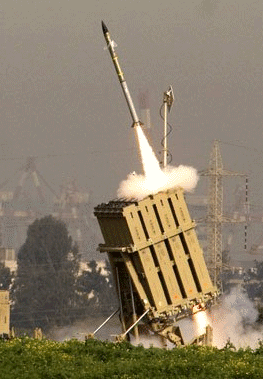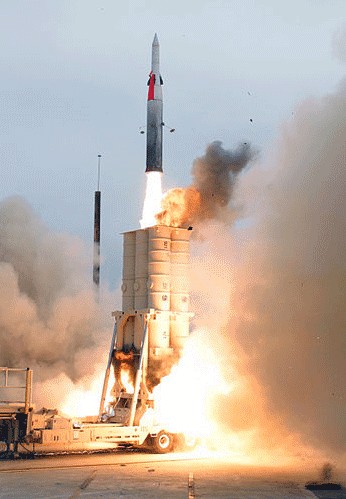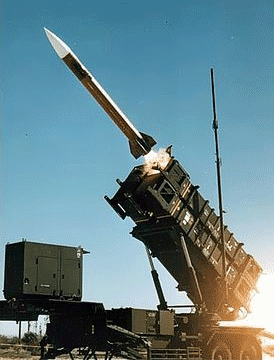Israel's Missile Defense System
(Updated June 2016)
Israel faces a variety of military threats that tests the Israel Defense Forces in its ability to protect civilians from attack. The Jewish State has defended itself no fewer than ten times on the battlefield, each victory reliant on its superiorly trained manpower and qualitative advantage over the enemies.
The proliferation of rockets and ballistic missiles across the Middle East - particularly in Iran, Syria, Lebanon and the Palestinian territories - has forced Israel to strengthen a new aspect of its defense doctrine – active anti-missile technology. Given Israel's small size, ballistic missiles represent an existential threat to Israel and it must therefore have an antimissile defense network that provides protection for the entire population. The philosophy of active missile defense - involving the development of advanced anti-missile systems as well as grouping together air, rocket and missile defense capabilities - underpins Israel's defense doctrine, also including early-warning, passive defense and counter-strike capabilities.
The missile threat is not confined to one geographical region or to any one type of rocket. Israel, in collaboration with the United States, has created a multi-layered missile defense apparatus in order to combat the threat and this defense system is considered one of the most advanced in the world.
In June 2016 the U.S. House of Representatives passed an appropriations measure that included $635.7 million earmarked for funding of Israel's missile defense programs.
Name: Iron Dome (כיפת ברזל)
Developers: Rafael Advanced Defense Systems; Elta; mPrest Systems
Target: Short-range rockets; Artillery/mortar shells (44 mile maximum distance)
Missile: Tamir Interceptor with electro-optic sensors and numerous steering fins
Cost: Battery - $50 million; Missile - $40,000
Components: Tracking Radar; Battle Management Control (BMC); Firing Unit
Firsts: Test-July 2009; Deployment-March 2011; Interception-April 2011
Overview:Israel's first line of missile defense, designed to protect from the short range rockets adn mortars fired by Palestinian terrorists in Gaza and Hezbollah in southern Lebanon. The system has the capability to identify and destroy projectiles before they land in Israeli territory. One of the most advanced features of Iron Dome is its capability to determine where an incoming rocket will land and to then only intercept projectiles that pose threats to populated areas. In March 2012, the Iron succeeded in its first real battle test, when it intercepted more than 60 rockets fired by Hamas. Since 2010, the US has budgeted more than $800 million for Iron Dome batteries. In August 2013, Israel stationed additional Iron Dome batteries in the north of the country as well as in Haifa and the Tel Aviv region to protect against possible missile threats out of Syria. The US spending bill for FY 2015 provides $3.7 billion in military aid to Israel, including $619 million specifically designated for the Iron Dome. |
 |
|
Name: David's Sling (קלע דוד)
Developers: Rafael Advanced Defense Systems; Raytheon
Target: Medium- to long-range rockets (63-185 mile range)
Missile: Stunner 2-stage Interceptor with electro-optical sensor & radar targeting
Timetable: First Test - Nov. 2012; Second Test Interception - Nov. 2013
Budget:$330 million from US government since 2006
Overview: David's Sling was developed as a flexible, multipurpose
weapon system capable of engaging aircraft, cruise missiles,
ballistic and guided missiles. Its Stunner interceptor
missile is designed for land-based, maritime and airborne applications
and is fitted with a dual-band imaging infrared and radio-frequency
seeker, as well as a multi-pulse rocket motor enabling all-weather
operation. David's Sling was designed to target incoming missiles
during their terminal phase, unlike the Iron Dome which intercepts
missiles at their highest trajectory. Its primary role will
be to intercept medium- and long-range ballistic and guided
rockets, such as the Iranian Fajr-5 and BM-25 as well as the
Syrian M-600 and Yakhont supersonic cruise missile. It will bridge the Iron Dome (short range interceptor) with the Arrow Theatre (long range interceptor). The use of US parts in Israeli Missile Defense Systems is contingent on being provided a veto over the export of the missile systems. In May 2014 the United States used this veto to prevent the Israeli military from selling the David Sling to Poland. The US spending bill for FY 2015 provides $3.7 billion in military aid to Israel, including $268 million designated for David's Sling and the Arrow defense systems. In December 2014 Ari Sacher, of Rafael's Air Superiority Systems Division stated in an interview with the Jerusalem Post that the new projectiles that they are testing for the David's Sling system will be able to intercept projectiles from well beyond Israel's borders. Sacher said that the missile system “has an interception range which ensures intercept before a threat enters Israeli territory.”
The U.S. Missile Defense Agency and the IDF carried out a successful test of the David's Sling system in April 2015, stating that “Next year it's going to be operational.” Israel Defense Minister Moshe Ya'alon held a press conference with U.S. House Speaker John Boehner during which he praised the work of the engineers and individuals involved and called the successful test a “major milestone.”
Israel's Defense Ministry and the Pentagon's Missile Defense Agency completed the last phase of trials for the David's Sling system on December 21, 2015. Agency leaders said David's Sling performed up to standards in a number of tests, calling the system “efficient, fast, and deadly.” The David's Sling system is capable of destroying heavy long-range rockets, short-range ballistic missiles and mortars, and enemy aircraft. This was the fourth and final test of the system.
The Israeli Air Force began to take delivery of the David's Sling missile system in early March 2016. Delivery of the system will be a gradual and phased process according to the Defense Ministry, with phase one including delivery of the system's multimission radar, Stunner interceptor missiles, and battle management center.
David's Sling missiles cost about $1 million each, compared to Iron Dome missiles which run closer to $70,000. |
 |
Name: Arrow Theatre System (חֵץ)
Developers: Israel Aerospace Industries (IAI); Boeing
Target: Long-range ballistic missiles; high-altitude nuclear warheads (Arrow-3)
Cost: $3 million per unit
Budget: $825 million from US; ~$300 million from Israeli government
Components: Interceptor; early-warning radar; command & control center; launcher
Firsts: Deployment (Arrow2)-October 2000; Test (Arrow3)-January 2012
Overview: The Arrow is designed to give Israel a full theatre ballistic missile defense capability. The original versions (Arrow-1 & -2) were initially greenlit in 1988 and became operation in 2000 to protect against long-range conventional missiles. In August 2008, the US and Israel began production of the Arrow-3 which is comprised of an exoatmospheric interceptor and proportional navigation to directly target an incoming missile outside of the earth's atmosphere, thereby preventing collateral damage from impact with a nuclear warhead. The Arrow has a greater accuracy (99% kill rate) and a longer targeting range (missiles of over 600 miles). Currently, Israel has two Arrow-2 batteries deployed in the center of the country and may deploy an Arrow-3 by 2014. The US spending bill for FY 2015 provides $3.7 billion in military aid to Israel, including $268 million designated for David's Sling and the Arrow defense systems. |
 |
Name: Patriot
Developers: Raytheon; Hughes; RCA
Target: High-Perfomance Aircraft; mid- and long-range tactical ballistic missiles
Missile: Surface-to-Air Interceptor (SAM)
Components: Stationary launcher (4 missiles); radar; command & control center
Timetable:First deployment (US) - 1984; First Activity (Israel) - 1991
Overview: The Patriot missile system was first used in Israel during the Gulf War when Saddam Hussein fired Scud missiles at Israel and it had a 40% claimed success rate in shooting down incoming missiles. The Israeli government, however, with dissatisfied with the performance and has worked to update the system and will now be phasing it out for the David's Sling. The upgraded versions, PAC-2 and -3, provide a more reliable and lethal capability to defeat advanced threats - including aircraft, tactical ballistic missiles, cruise missiles, and UAVs - in almost all operational combat environments. The newest Israeli version is set to replace the four-missile stationary launcher with a 16-missile launcher, which will make it better equiped to contend with a prolonged barrage of missiles. In 2006, Israel stationed a Patriot battery in Haifa to protect from Hezbollah rockets. Another was placed in the north during 2012. In August 2013, the Israeli Air Force planned to place a Patriot battery in the Galilee to protect from threats out of Syria. Israel purchased four Patriot missile batteries from Germany in May 2015. |
 |
Sources: IDF Spokesperson;
Raytheon Company;
Wikipedia (Patriot, Arrow, David's Sling, Iron Dome);
Department of Defense;
CRS Report;
Space Daily;
Missile Monitor;
MissileThreat.Com;
Defense Industry Daily;
StraFor;
CIA Proliferation Report;
Cohen, Gill. “Defense Minister Ya'alon: Israel recieved 4 Patriot missile batteries from Germany,” Haaretz (May 10, 2015);
Opall-Rome, Barbara. “US, Israel Start Delivering David’s Sling System to Israel Air Force,” DefenseNews (March 2, 2016);
Shimoni Stoil, Rebecca. “US House okays funding boost for Israel’s missile defense,” Times of Israel (June 17, 2016)
|